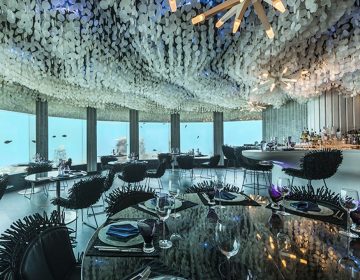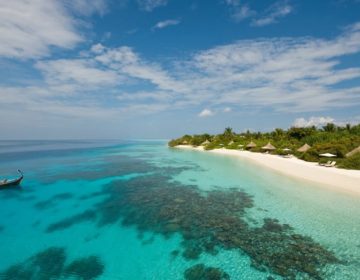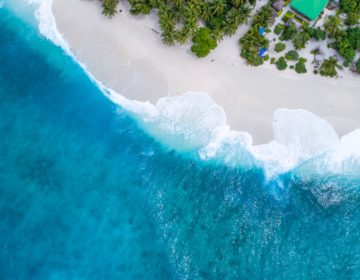Madi Thila
In Madivaru Kandu is a large underwater thila, the biggest in North Malé Atoll, which his four kilometers wide and rises in parts to three meters. The north-west side is called Madi Thila and often during the north-east monsoon, mantas feed along this part of the reef.
 During the north-east monsoon, mantas feed along this part of the reef.
During the north-east monsoon, mantas feed along this part of the reef.
Madigaa, Ihiga, and Madivaru
On the outside reef off Medhu Finolhu (Reethi Rah Resort) are thee similar dives and all are good for beginners. Each dive starts with a small inlet in the reef at 10 meters and all slope to a sandy bottom that continues to 30 meters.
At Ihiga and Madigaa, isolated coral rocks are scattered around the sand and attract a wide variety of marine life, including grouper, sweetlips, snapper and moray eels. At Ihiga, there is one big rock with a small cave at 16 meters. Stingrays and white-tip reef sharks are common on the sand at all sites. Sometimes there are six or seven sharks close together, and garden eels are thickly spread across the sand and look like a field of corn wavering in the breeze. At Madivaru, leaf fish can be found at a rock at 15 meters and all sites there is a good chance of seeing eagle rays at any time and manta rays between December and April. The reef top is between five and 10 meters. Generally, the quality of the coral growth on the reef top is poor. This is partly due to rough seas crushing coral on the outside of the atoll.
 At Madivaru, leaf fish can be found at a rock at 15 meters.
At Madivaru, leaf fish can be found at a rock at 15 meters.
Blue Lagoon
Keen divers often make exciting discoveries in the lagoons of their resort island. At Ziyaaraiyfushi, Blue Lagoon is the house reef dive and is marked by a buoy near the end of the jetty. This dive has a sandy bottom and sloping sandy edge from around four to 20 meters. It has varied invertebrate and fish life, and with clear water conditions and good light, excellent photographs can be taken. Pufferfish, banded trevally, and triggerfish make good subjects and on the sand are four or five different species of lizardfish. Goby like the sandy environment and the white-barred sleeper goby and timid black-spot worm goby can be observed here when diving carefully and with patience.
 The timid black-spot worm goby can be observed here when diving carefully and with patience.
The timid black-spot worm goby can be observed here when diving carefully and with patience.
Another uncommon fish occurs about 100 meters to the south of the diving buoy. It is the long-rayed sand diver. It is a shy fish, not more than 10 centimeters long, and big schools of them occur here. At this point, the sand bed is rich with dollar urchins. These urchins are visible one moment and 30 seconds later can bury themselves in the sand.
 The long-rayed sand diver is a shy fish, not more than 10 centimeters long, and big schools of them occur here.
The long-rayed sand diver is a shy fish, not more than 10 centimeters long, and big schools of them occur here.
West Point
The western end of Makunudhoo reef is known as West Point. It is suitable for beginners with reef topography being the central feature.
Z Reef
This dive is at the northwest end of Makunudhoo reef. It has some interesting terrain with sand corridors running roughly parallel to the reef at depths around 15 meters. The sand is spread in a zig-zag fashion between a second coral reef barrier that rises to three meters before dropping to a sandy bottom at 25 meters on the outside. Coral growth is generally poor, but the reef features some nudibranchs and flatworms as well as bigeye and butterfly, while on the sand are garden eels, goatfish, and white-tip reef sharks.
 The reef features some nudibranchs.
The reef features some nudibranchs.
Ziyaarai Thila
In the middle of the wide channel between Himmiya Faru and Ziyaaraiyfushi is a long thila running roughly east-west at about nine meters below the surface. At the western end, near the outside of the atoll, manta rays are seen during the north-east monsoon.
Kuda Thila
This is a spectacular 100-meter long thila located on the south side of the larger Ziyaarai Thila. The top of the Kuda Thila is at 16 to 18 meters and off the southern side is a line of large rocky outcrops beginning at depths ranging from 22 to 25 meters. Between the rocks and Kuda Thila is a canyon with a depth of around 28 meters. There are plenty of overhangs on this thila, and soft coral is on all the cliff faces. Shark and Napoleon are regulars, while on the reef top are big schools of blue-striped snapper and small schools of surgeonfish.
 On the reef top are big schools of blue-striped snapper.
On the reef top are big schools of blue-striped snapper.
Diving Hints:
Divers should be aware that powerful currents occur in Makunudhoo Kandu and can be dangerous, especially outgoing ones. Divers can see most of the features of the reef if they limit their depth to 25 meters to maximize bottom time before ascending to make an open water safety stop. A safety balloon should always be carried here.
Makunudhoo Kandu – Marine Protected Area
The entire north side of Makunudhoo Kandu has been declared a Marine Protected Area. It is just over two kilometers in length and has several popular dive points.
Kuda Faru (Saddle, Shark Point)
Kuda Faru is one of the diving highlights of the northwest. It is a finger of reef extending into the channel about 500 meters from the outside corner of Makunudhoo Kandu. The reef is like a thila. The top is at 13 meters, slightly oval and about 50 meters long. It is separated from the main reef by a sand saddle at 15 meters. The thila extends into Makunudhoo Kandu for some distance on the southern side. The northern side of the thila is the best place to view both white-tip and grey reef sharks. With a strong incoming current, divers can look over the deep sand valley leading to the saddle where as many as 20 sharks, many juveniles, can be seen at one time. The reef top has a good range of hard and soft coral and on the outer slopes are sponges, sea whips and sea fans. Eagle rays can be seen here between November and May.
 The northern side of the thila is the best place to view both white-tip and grey reef sharks (seen above).
The northern side of the thila is the best place to view both white-tip and grey reef sharks (seen above).
There is a large overhang at 27 meters with squirrelfish roaming the dark interior and nurse sharks are sometimes found inside. Turtles and Napoleon are usually seen.
Diving Hints:
Currents are funneled through the saddle at an accelerated rate. Even slight currents become swift torrents here. Strong incoming currents may take the swim back to the main reef difficult so a safety balloon should always be carried here in case an open water safety stop has to be made.
Eri Faru
This is a good beginner’s dive. Experienced divers will relish the great diversity of marine life here too. A recess in the reef has created a long sheltered inlet with a sandy bottom about 17 meters deep. White-tip reef sharks are seen resting on the sandy bottom.
On the outside of this 20-meter wide sand, street is a long reef with the top at 14 meters, descending to more than 30 meters on the outside into Makunudhoo Kandu. On the reef are a range of invertebrates: feather stars of all colors, spider shells, sponges, lobster, and sea stars. Healthy hard coral covers the reef, and sea fans are patchy. Lionfish and Napoleon are everywhere. Turtles are frequently seen along the entire reef of Makunudhoo Kandu. This dive is a refreshing change and full of fascinating features.
 On the reef are a range of invertebrates: feather stars of all colors, spider shells (seen above), and sponges.
On the reef are a range of invertebrates: feather stars of all colors, spider shells (seen above), and sponges.
Coral Garden
Located on the eastern side of Himmiya Faru, this is an excellent dive for beginners. It has a small thila two meters from the surface just out from the main reef. As the name suggests, it has plenty of quality hard coral, mostly young and delicate. A multitude of reef fish live among the coral, and it is easy to spend the entire dive here. The current can go both ways along the reef, and the best way to dive here is to start well up current and drift along the reef onto the garden.
 A multitude of reef fish live among the coral.
A multitude of reef fish live among the coral.
Himmiya Beyru
On the outside of Himmiya Faru is a small indentation in the reef, 500 meters to the north of Makunudhoo Kandu corner. It is a good beginner dive with a reef sloping gently from five to 25 meters. Just out from the main reef is a small thila at 25 meters, making the site a good dive for more experienced divers as well.
Akirifushi Caves
The caves lie on the southern side of Akirifushi. They are about 150 meters west of exposed rock on the reef edge. This entire reef is alive with coral growth and a healthy range of reef fish and well worth a dive. The reef bows in and out and the drop off is characterized by steep walls between three and 25 meters. At one point is a range of caves and ledges all the way down the reef-face. Inside the caves are soft yellow coral, sponges, and sea fans with feather stars attached. There are also patches of stinging hydroids. The reef is a haven for morays, stingrays, turtles, and pufferfish.
 Inside the caves are soft yellow coral, sponges, and sea fans with feather stars attached.
Inside the caves are soft yellow coral, sponges, and sea fans with feather stars attached.
Olhahali Caves
These caves are on the northern side of Olhahali. There are a couple of small caves at 15 and 20 meters, but the main attraction is a big cave 40 meters long at a depth of 25 meters. On the ceiling is blue and white soft coral, also some sea fans and sponges on the walls. At its base is a mixture of sand and coral on which sea whips grow.
Experience these once-in-a-lifetime dives and book your hotel here.
(Source: Dive Maldives: A Guide to the Maldives Archipelago. Tim Godfrey. Atoll Editions, 2015)



